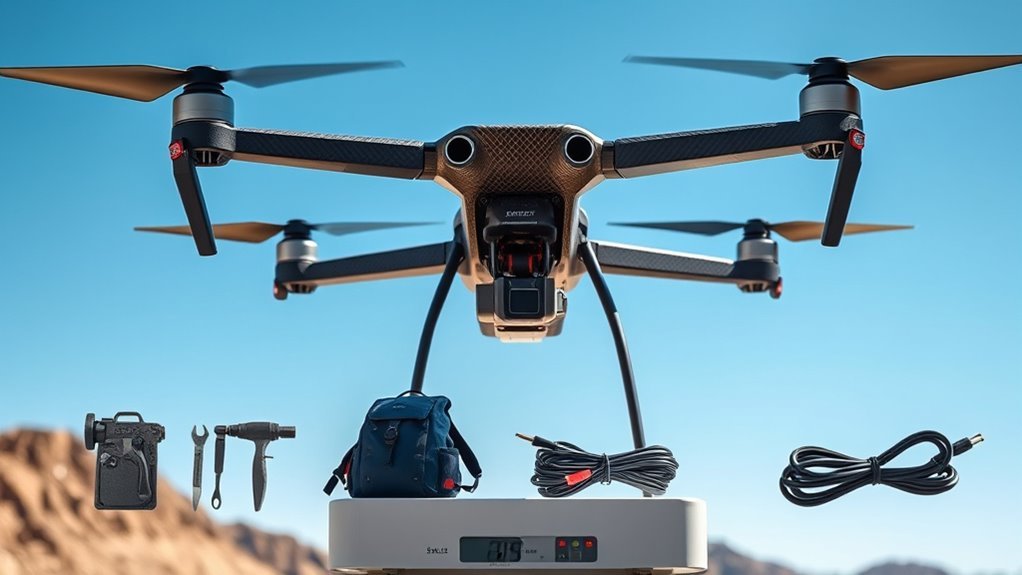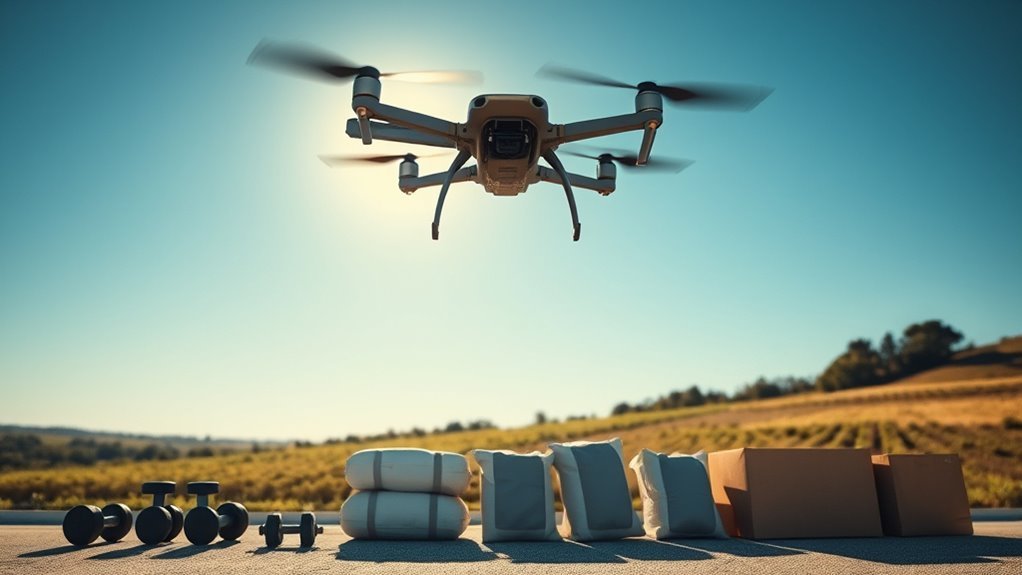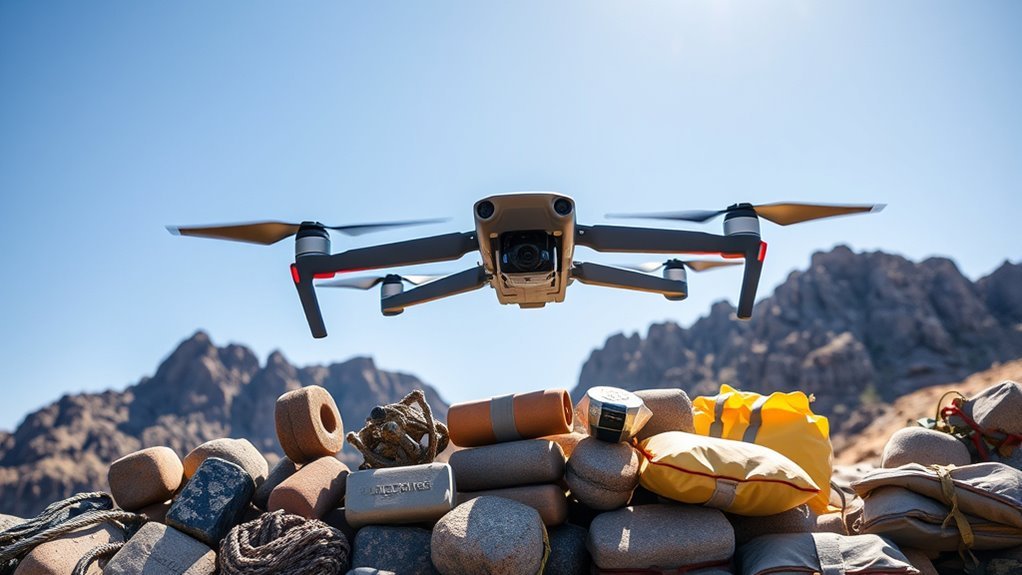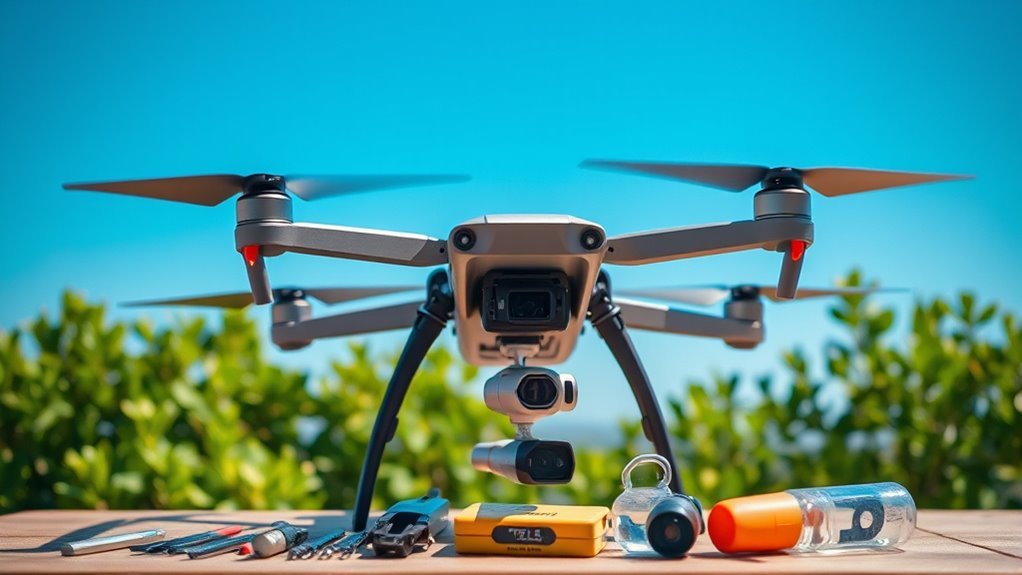Several factors affect how much weight your drone can carry. Its design and structure play a vital role; lightweight materials enhance performance. Motor power and efficiency also matter, as they determine lifting capability. Battery capacity influences flight duration and payload limits. Propeller size and type impact lift generation, while proper weight distribution guarantees stability. Environmental conditions, like wind and altitude, further affect capacity. Explore these aspects further to better understand your drone’s performance limitations.
Drone Design and Structure

When considering drone weight capacity, the design and structure play an essential role, as they directly influence the drone’s ability to carry payloads efficiently. The choice of drone materials markedly impacts structural integrity. Lightweight composites, such as carbon fiber or reinforced plastics, enhance durability while minimizing weight, allowing for increased payload capacity. Conversely, heavier materials can compromise flight performance, limiting the overall weight you can carry. A well-engineered frame with ideal geometry distributes stress effectively, preventing structural failure during operation. Additionally, the design must account for load distribution to maintain stability and control in flight. For example, the payload capacity of the Yuneec Typhoon H3 is up to 1.5 kg, which showcases how design impacts functionality. By focusing on advanced materials and innovative structural designs, you can maximize your drone’s potential, achieving greater freedom in your aerial endeavors. Understanding signal attenuation is also crucial, as it can affect the drone’s performance when carrying heavier payloads.
Motor Power and Efficiency

The efficiency of a drone’s motors greatly influences its weight capacity and overall performance. When considering motor power, you’ll want to focus on several key factors that directly impact how much weight your drone can carry:
- Motor Torque: Higher torque allows for greater lifting power, essential for carrying heavier payloads.
- Efficiency Ratings: Motors with higher efficiency ratings convert more electrical energy into thrust, optimizing performance.
- Propeller Size: Larger propellers can generate more lift but require more powerful motors to maintain efficiency.
- Weight Distribution: Balanced weight distribution enhances motor efficiency, reducing strain and improving flight stability. The advanced algorithms for payload management optimize how weight is handled during flight, ensuring stability and performance under heavy loads.
Battery Capacity and Flight Time

When considering battery capacity, it’s vital to recognize how battery type impacts overall performance and weight. The weight-to-power ratio directly influences your drone’s flight duration and payload capacity, making it essential to choose wisely. Additionally, understanding flight duration limitations helps you optimize your drone’s operational efficiency. Battery capacity significantly affects payload capacity, which is crucial for determining how much weight a drone can effectively carry. A drone’s flight endurance is also influenced by its battery technology, which can determine the operational flexibility for various tasks.
Battery Type Impact
Although various factors influence a drone’s weight capacity, the type of battery used plays an essential role in determining both battery capacity and flight time. Different battery chemistries, such as lithium-polymer or lithium-ion, affect the voltage impact and overall performance. Here are some key considerations:
- Battery Chemistry: Different materials yield varying energy densities and efficiency.
- Voltage Impact: Higher voltage can enhance power delivery but may reduce flight time.
- Capacity Rating: Measured in milliamp-hours (mAh), it directly correlates with flight duration.
- Weight of Battery: Heavier batteries can reduce payload capacity despite higher capacity ratings.
Understanding these factors can help you optimize your drone’s performance and guarantee it meets your weight-carrying needs effectively.
Weight-to-Power Ratio
To achieve ideal flight performance, understanding the weight-to-power ratio is crucial, as it directly influences a drone’s ability to carry payloads efficiently. The balance between a drone’s weight management and its power optimization is critical; if the power isn’t sufficient to lift the weight, flight becomes compromised. A high weight-to-power ratio indicates better performance, allowing you to maximize payload capacity without sacrificing stability. This ratio is determined by your battery capacity, which impacts the drone’s thrust capabilities. Efficient power usage enables longer flight times, but overloading the drone can lead to decreased efficiency and increased energy consumption. Prioritizing the right balance guarantees you can explore and utilize the full potential of your drone’s capabilities.
Flight Duration Limitations
While battery capacity plays a pivotal role in determining a drone’s flight duration, various factors can further influence this essential aspect. Understanding these elements can help you maximize your drone’s flight time and navigate its endurance limits effectively. Here are four key factors to evaluate:
- Weight Load: Heavier payloads drain the battery faster, reducing flight time.
- Aerodynamics: A well-designed frame can minimize drag, enhancing efficiency.
- Flight Conditions: Wind and temperature can impact battery performance and energy consumption.
- Flight Mode: Different flying styles, like aggressive maneuvers, can considerably affect battery usage.
Propeller Size and Type
When selecting propellers for your drone, the diameter greatly influences lift capacity and efficiency. Variations in blade shape can also affect aerodynamics, impacting overall performance and stability. Additionally, the material strength of the propellers plays an important role in durability and weight distribution, which are essential for maximizing payload capabilities.
Propeller Diameter Impact
Propeller diameter plays an essential role in determining a drone’s weight capacity. Larger propellers can enhance propeller efficiency, allowing your drone to lift heavier loads. Here’s how diameter impacts performance:
- Lift Generation: Bigger propellers create more lift, vital for carrying additional weight.
- Thrust-to-Weight Ratio: A larger diameter improves this ratio, enhancing overall stability and control.
- Power Consumption: Larger propellers often operate at lower RPMs, which can lead to more efficient power usage.
- Propeller Design: The diameter interacts with blade pitch and material, affecting durability and performance under load.
Understanding these factors helps you select the right propeller diameter for your drone, maximizing its potential while maintaining freedom in flight.
Blade Shape Variations
Blade shape variations greatly influence a drone’s performance and weight capacity. The design of your drone’s propellers directly affects blade aerodynamics, which plays a vital role in lift generation. For instance, wider blades can enhance lift but may also increase drag, limiting efficiency. Conversely, narrower blades typically reduce drag but might struggle to generate sufficient lift, especially under heavy loads. The pitch of the blades also matters; a higher pitch can improve thrust but may sacrifice overall stability. Choosing the right propeller size and type guarantees ideal airflow, maximizing lift while minimizing energy consumption. Understanding these dynamics empowers you to select the best blade design, tailoring your drone to meet specific weight-carrying needs and performance goals.
Material Strength Considerations
While selecting the right materials for drone propellers may seem secondary to design, it greatly impacts weight capacity and overall performance. The material properties you choose directly influence the propeller’s strength and durability, affecting how much weight your drone can handle. Strength testing is vital to guarantee the propellers can withstand the demands of flight. Here are key considerations:
- Material Type: Carbon fiber offers high strength-to-weight ratios, while plastic is lighter but less durable.
- Thickness: Thicker blades can handle more stress but may increase weight.
- Shape: Aerodynamic designs reduce drag, enhancing performance.
- Finish: Smooth surfaces minimize turbulence, improving efficiency.
Weight Distribution and Center of Gravity
Understanding weight distribution and center of gravity is essential for optimizing a drone’s performance and payload capacity. Proper center alignment guarantees that the weight is evenly distributed across the drone, which greatly affects its stability control. When the center of gravity is located in the correct position, your drone can maneuver more effectively, reducing the risk of instability and crashes. If the weight is skewed, it can lead to uneven lift, making it difficult for the drone to maintain altitude and direction. Balancing your payload and adjusting its position can enhance flight performance, allowing for greater freedom in flight paths. By prioritizing weight distribution, you can maximize your drone’s capabilities while guaranteeing safety and efficiency. Additionally, understanding how battery capacity affects overall weight management can further improve your drone’s operational range and performance. Excess weight can strain propulsion systems, reducing battery life and affecting navigation systems.
Payload Attachment Methods
As you explore various payload attachment methods, it is crucial to recognize that the way you secure cargo can greatly influence a drone’s overall performance and safety. Choosing effective payload attachment techniques guarantees stability and reliability during flight. Here are some secure mounting options you might consider:
- Gimbals – Great for stabilizing cameras or sensitive equipment.
- Velcro Straps – Quick and adjustable, ideal for lightweight payloads.
- Custom Mounts – Tailored solutions for unique payload shapes and sizes.
- Magnetic Mounts – Suitable for metallic cargo, allowing easy attachment and removal.
Additionally, it’s important to note that different drones can support varying payload capacities, such as the Guardian Agriculture Drone’s ability to carry up to 10 kg for agricultural operations. The payload capacity of a drone can significantly impact its suitability for various applications.
Environmental Conditions
Environmental conditions play a pivotal role in determining a drone’s weight capacity and overall performance. Weather impact can greatly alter how much your drone can carry. High winds increase wind resistance, making it harder for your drone to maintain stability while handling heavier payloads. Temperature effects also come into play; extreme heat or cold can impact battery efficiency and motor performance, thereby reducing your drone’s lifting capability. Additionally, humidity levels can affect the drone’s electronics and overall aerodynamics. High humidity can lead to moisture accumulation, potentially increasing weight and decreasing efficiency. Understanding these environmental factors helps you optimize your drone’s performance and guarantee it operates within its weight limits, maximizing your freedom to explore the skies. Furthermore, altitude and air density effects play a significant role in how much weight a drone can effectively lift, as thinner air can decrease propulsion efficiency.
Flight Mode and Stability Features
Weather conditions can influence not just a drone’s capacity but also the mode in which it operates. Different flight modes can enhance flight stability, enabling your drone to handle various payloads more effectively. Here are some essential features to evaluate:
- Altitude Hold: Maintains a steady height, vital for controlled descent.
- GPS Mode: Aids in stable navigation, ensuring the drone remains on course.
- Acro Mode: Provides more freedom but can compromise stability under heavy loads.
- Return-to-Home: Automatically brings the drone back, providing safety under adverse conditions.
Additionally, drones like the Draganfly X4-ES, which employs multi-axis stabilization algorithms, significantly enhance stability in turbulent conditions, allowing for more effective payload management. The Draganfly Commander 2, for instance, features advanced stabilization that improves handling and safety during flights with varying loads.
Understanding these features helps you optimize your drone’s performance and load capacity, allowing for greater freedom in your aerial endeavors.
Regulations and Manufacturer Specifications
While understanding the regulations and manufacturer specifications is crucial for optimizing your drone’s weight capacity, it is important to recognize that compliance directly impacts operational safety and performance. Regulatory compliance guarantees your drone operates within legal parameters, which can include weight limits, payload restrictions, and safety protocols. Each manufacturer provides specific guidelines regarding maximum load capacity, which are based on engineering assessments and testing. Ignoring these guidelines not only risks violating laws but can also lead to equipment failure and safety hazards. As a result, you should always refer to both regulatory standards and manufacturer recommendations to maximize your drone’s potential while guaranteeing safe operation. Balancing these factors empowers you to utilize your drone effectively without compromising safety or performance. Additionally, failure to register a drone can lead to significant legal penalties, including fines reaching thousands of dollars.
Frequently Asked Questions
How Do Drone Materials Impact Payload Capacity?
The materials used in drone construction, like carbon fiber and aluminum frames, considerably impact payload capacity. Carbon fiber’s lightweight strength allows for higher loads, while aluminum frames offer durability but may increase overall weight, limiting capacity.
Can Weather Conditions Affect Drone Weight Limits?
Like a bird battling fierce winds, you’re reminded that weather conditions can greatly affect your drone’s weight limits. Wind resistance and temperature fluctuations can impact stability, making it essential to take these factors into account for safe operation.
What Role Do Sensors Play in Weight Capacity?
Sensors play an essential role in weight capacity. Different sensor types and effective sensor integration optimize performance, ensuring drones maintain stability and efficiency while carrying loads, ultimately enhancing operational freedom and the effectiveness of your missions.
How Does Flight Altitude Influence Payload Performance?
Altitude effects greatly impact a drone’s lift efficiency. As altitude increases, air density decreases, reducing the drone’s ability to generate lift. You’ll need to account for this when maximizing payload performance at higher elevations.
Are There Any Legal Restrictions on Drone Payloads?
Steering through the skies, you’ll find drone regulations can tether your creativity. Understanding payload guidelines is essential, as legal restrictions vary by region, ensuring safety while you explore the potential of your drone’s carrying capacity.

